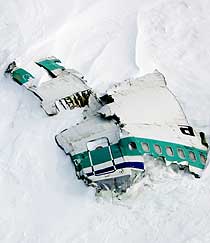Friday, March 15, 2013
Controlled Flight Into Terrain
While some technical nomenclature obfuscates what's really going on, controlled flight into terrain (CFIT) is a term that means exactly what it sounds like. When an airworthy, uncompormised aircraft is flown unknowingly into the ground or water, a CFIT accident results. You can read more about that here:
Controlled Flight Into Terrain
CFIT doesn't happen as often as it used to, and it's almost unheard of in commercial airline service in the developed world. Lack of visibility is always a contributing factor, since windows do a good job at letting situational awareness in so long as there's light and clarity in the air. That said, CFIT accidents can and have happened everywhere from rural nights in Florida to tropical fog in Colombia to austral whiteouts in Antarctica. Significant research has been invested for decades on keeping airplanes from wandering into the ground without their pilots' knowledge, and it looks like it's paying off. The last time a revenue service flight went down over US soil because the pilots lost track of the ground's location happened in Guam 16 years ago.
Since light, general aviation aircraft have fewer tricks than airliners have to light the way through flight at night, in the rain, and in fog, CFIT accidents are much more common among the Cessnas and Pipers than they are among Boeings and Airbuses. With some good fortune and a better regulatory and engineering environment, the trend for big planes today will hopefully become that for small planes tomorrow.
Because really, this sort of thing just shouldn't happen.
Subscribe to:
Post Comments (Atom)

No comments:
Post a Comment